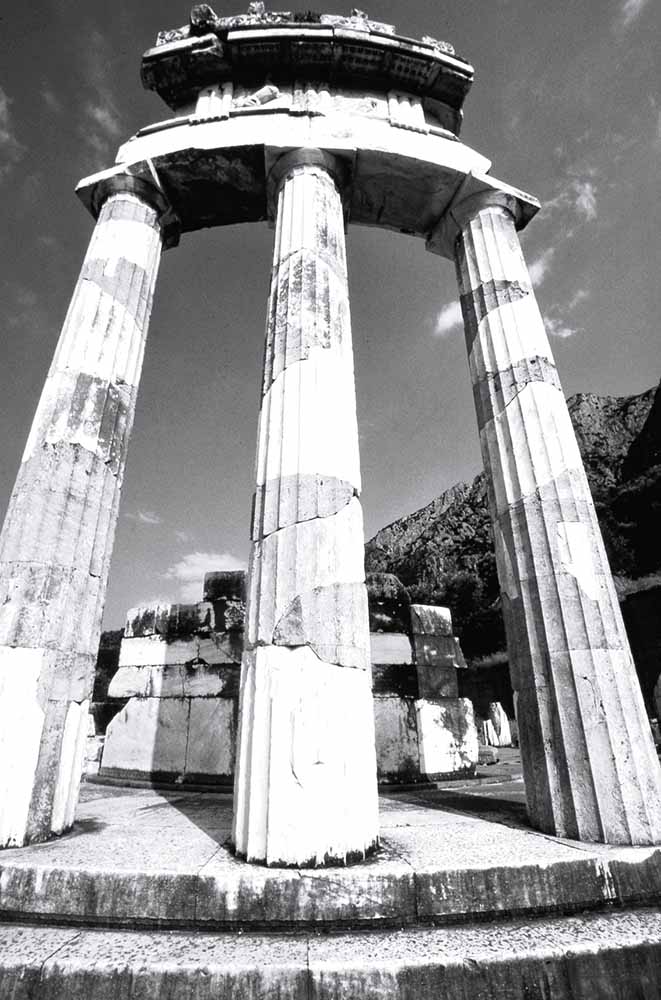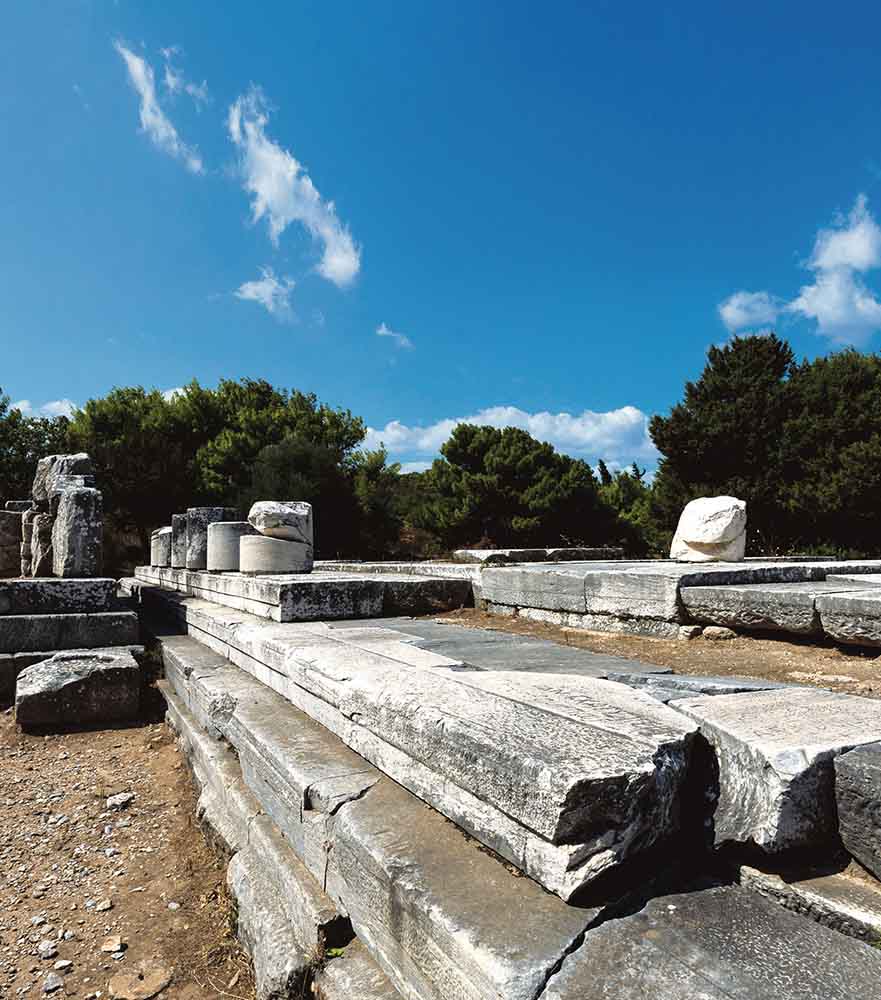In Search of the Forgotten Ancient Temples in Greece




 +10
+10 In Search of the Forgotten Ancient Temples in Greece
In the excerpts of the ancient Greek monuments of Greece, their meaning is not the faithful copying of shapes and landscapes, but the creative process which awakens the depths of the human soul, left to emotion that evokes the grandeur of the spectacle.
Nature and History together. We talk about teratogens of nature, but at the same time their maturely thought-out architectural lines, that give a human meaning. The monument alone, in its fatal loneliness, colorless, unexpressed, abandoned ruin, turns to man and causes them to go down into the stream History.
The Sanctuary of the Great Gods in Samothrace
Known as the Sanctuary of the Great Gods, is one of the principal Pan-Hellenic religious sanctuaries, located on the island of Samothrace. Mysterious ceremonies were held here, which date back to the 7th century BC, with the deities worshiped being different from those of the Olympian gods and related to the dark deities of Kaveiron. It was located near the ancient city of Samothrace – today’s Paleopolis – and received missions of ambassadors from other city-states during the festivities. It remained an important religious site during the Roman period, with the emperor Hadrian visiting it and the author Marco Terentio Barron describing the mysteries before it began to disappear into obscurity in late antiquity. The site is also known as the place where the statue of the Victory of Samothrace was originally located. The sculpture has been on display at the Louvre Museum since 1884.
Dion at mount Olympus
At the northern foot of Mount Olympus, Dion dominates. It was the pre-eminent holy city of Macedonians and the sanctuary of Zeus. It reached great prosperity during Hellenistic times, but also in Roman times, as it was one of the earliest Roman colonies in Macedonia. Alexander’s love for Dion is also evident from his desire recorded in his will, to build a luxurious temple dedicated to Zeus. Victim of the Ostrogothic invasion, Dion never healed it’s wounds. The floods of the Vafyra river, the earthquakes and the time will cover with oblivion the city that was abandoned during the 5th century AD. Its inhabitants moved to safer areas at the foot of Olympus.
First Ancient Theater of Larissa
The First Ancient Theater of Larissa, associated with the worship of the god Dionysus, is the largest theater in Thessaly with the capacity of 10,000 people. It is located on the south side of the Acropolis Hill (Fortress Hill), and it is the trademark of the city. It was built in the center of the ancient city during the reign of King Philip V of Macedonia at the end of the 3rd century BC. The theater was in use for six centuries until the end of the 3rd or beginning of the 4th century AD. The theater has the typical architecture of the Hellenistic theater with the three basic elements; hollow, orchestra and stage with a diameter of about 25 meters. During the reign of emperor Octavian Augustus and the successor of Tiberius, inscriptions were found in their honor on the cornices of the stage.
The Ancient Agora of Kos
The Ancient Agora was the commercial and social centre of Kos. It was originally built in the 4th century BC in a short distance from the city port. The currently visible part, apart from the market, are the fortification of the city, the sanctuaries of Aphrodite and Hercules, building with the remains of private houses, but also part of the ancient port. The ancient market consisted of three main galleries, North, East, and West which in their centre met in a large inner courtyard. The north part connected the market with the city walls while the other two had various shops that served the daily needs of the citizens. Most of the ancient market is buried under the modern city. In fact, its southern part came to light with recent excavations opposite the altar of Dionysus which led to the restoration of two columns which belonged to the ancient market.
The temple of Apollo in Ancient Corinth
The temple of Apollo was built around 530 BC and it is a trademark for Corinth. With monolithic Doric columns, originally had six columns in width and fifteen at length, of which today only seven stand in a prominent position above the ruins of the ancient market.
The Dome of Delphi
The Dome of Delphi belongs to the buildings that adorned the sanctuary of Athena Pronea. It has been described as one of the most beautiful and exceptional creation of ancient Greek architecture, with two moldings, triglyphs and metopes. The varied combination and mixture of different architectural styles in the same building was complemented by natural polychromy, resulting in the use of different materials. The building was designed by the architect Theodoros Phokeas.The architectural sculptures of Tholos have been paralleled with those of the Asclepieion of Epidaurus. Some scholars suggest that the cyclic altan on display at the Archaeological Museum of Delphi that depicts women hanging red ribbons, belongs to the Dome structure.
Treasure of the Athenian Delphi
The Athenian Treasure was dedicated by the Athenians for their victory over the Persians and housed the votive offerings of the Athenians to the god Apollo. It is located at the first turn of the Iera Odos, which led to the temple of Apollo and to the oracle of Delphi. It dates between 510 and 480 BC.
The Temple of Poseidon at Sounio
A first temple began to be built in the early 5th century BC but was destroyed before it was completed, by the Persians in 480 BC. Doric, double in representation, six by thirteen columns. The second temple began to be built in 449-448 BC by order of Pericles. The architect is unknown but he is probably the one who designed the temple of Hephaestus at the Agora of Athens, the Temple of Ares and the temple of Nemesis in Ramnounta, as these four temples were almost identical to each other.
The sanctuary of Poseidon had been almost ruined during the Roman period. In recent years, parts of the temple have been detached and transferred either to museums or in private collections.
Temple of “Nemesis” Ramnountas at Marathon
Ramnountas was an ancient town and municipality of Aiantida which was an area of Ancient Attica and a tribe of ancient Athens. Ramnountas today is an archeological site of Eastern Attica with its impressive ruins located northwest of the modern settlement of Agia Marina Grammatikou of the Municipality of Marathon. Τhere was a place of worship for the relentlessly revengeful goddess Nemesis. It is one of the best preserved archeological sites.
Τhe Heraion of Olympia
The Heraion of Olympia, also known as the temple of Hera in Olympia is located inside the sanctuary of Altea and on its northwest side. It was built on the southern foothills of Kronio hill and is one of the oldest examples of monumental temple construction in Greece. Ιt was built by the inhabitants of Skillounta (ancient city of Ilia) and according to Pausanias, it was built eight years after the assumption of the reign of Oxilos in Ilida around 1096 BC. The most valuable works of the sanctuary were kept in Heraion Olympia, among which was the famous Hermes of Praxiteles, the record of the holy truce, the statues of the Hours made of gold and ebony by the sculptor Emilos, the bank of Kolotis the shrine of Kypselos. Today the foundations are preserved, the huge uprights of the nave and the lower part of the columns. Four columns have been restored while fragments of the clay decoration of the thrigos and the clay central cape of the temple are exhibited in the Archaeological Museum of Olympia. In front of the temple there is the altar of Hera, on which the touch of the Olympic flame is made by the priestess, according to the ritual.
The Temple of Aphaia in Aegina
The Temple of goddess Athena Aphaia is located at a height of 160 meters on the east side of the island. The deity is identified with the Cretan Diktynna or Vritomarti. According to greek mythology, the king of Crete Minoas fell in love with Vritomarti, chased her and she fell into the sea to escape. However, she was rescued by fishermen who took her to Aegina, but she was still being chased. So, she took refuge in the sacred grove of Artemis and disappeared with the help of the goddess. Her relationship with Artemis is certain, as Vrito marti sometimes is mentioned as a nymph, her daughter, while Artemis herself has the cult names Aphaia, Vritomarti, Diktynna. When the locals tried to find her, they found a statue in its place and so they named it Aphaia (means invisible). In that place the Aeginians founded one sanctuary and later a temple was built, which dates back to the beginning of the 5th century BC.
The Temple of Zeus in Olympia
Temple of Zeus at Olympia was built between 427 and 456 BC and it was in Doric style. It is located in the courtyard of Altea in the sanctuary dedicated to Zeus and where the Olympic Games were held. The site was probably a place of worship from the end of the Mycenaean period. Until then, Zeus was worshiped in the temple of Hera. In 426 AD Theodosius II ordered the destruction of the sanctuary and the earthquakes of 522 and 551destroyed the remains of temple, leaving the Temple of Zeus partially buried.
The Temple of Epikourios Apollon
The temple of Epikourios Apollon in Vasse of Figalia is one of the most important and imposing of antiquity. It was dedicated by the Figαlleis to Apollo because he helped them overcome a plague epidemic. It stands at 1,130 meters in the center of the Peloponnese, on the mountains between Ilia, Arcadia, and Messinia. The temple was built in the second half of the 5th century BC (420-410 BC). It’s attributed to Iktinos the architect of the Parthenon. This monument, one of the best preserved of classical antiquity, was the first in Greece to be declared a World Heritage Site by UNESCO in 1986. Part of the temple’s frieze was detached in 1814 and is on display at the British Museum in London.
The Temple of Nemeios Zeus in Nemea
The temple of Nemeios Zeus is one of the monuments of classical architecture. Built in 330 BC, the temple was an architectural triumph of applied engineering, which combines the elements of the classical Doric temples with creative rendering of the Hellenistic element. It was the religious center of the sports competitions. The eastern facade as well as the western colonnade consisted of six columns of Doric rhythm. Above these columns dominated the gable of the Temple. Along the colonnade consisted of twelve corresponding columns to the north and south side. The temple had a total of 32 columns about ten meters high with each vertebra weighing two and a half tons. A staircase led inside the Temple, to statue of Zeus.
In the years of the Christian era it was leveled. Thus, in the engravings of travelers of the 18th and 19th century it appears with all three columns standing. The only thing that saved the remains from their complete disappearance was the absence of a later settlement near the temple.




















